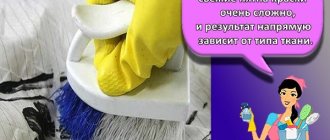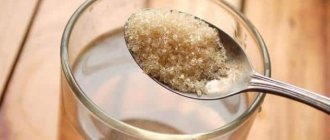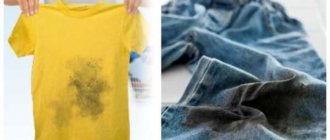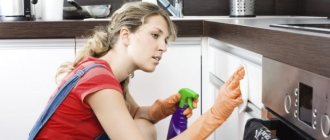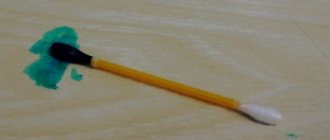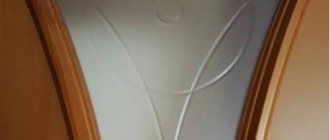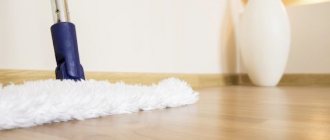The appearance of greasy stains is not such a rare life situation. Grease that accidentally gets onto various objects can be difficult to remove so that not a trace of the stain remains.
Proven methods from the arsenal of home recipes will come to the rescue. It is important to take into account the type of soiled surface, the extent of the contamination and how long ago the mark was made.
We will tell you in this article how to remove grease stains from various surfaces.
The best detergents
It is worth cleaning the kitchen regularly. Wipe table surfaces, sinks, and burners after each use. And the floor - every day, walls, hanging cabinets - once a week. To remove grease, many people use special products that are highly effective.
"Amway"
The concentrated composition is able to remove old stains and drops of grease from smooth surfaces of furniture, sinks, and walls in the kitchen. In addition to effective degreasing, it also produces a pleasant smell in the room. The advantage of the product is the absence of streaks after use, minimum aggressiveness.
Before use, dilute the solution with water in a ratio of 1:4, spraying it on the walls of furniture and walls with a special gun. Then wipe dry.
"Shumanit"
The liquid is suitable for removing stubborn dirt, burnt grease, and oil from smooth furniture facades, stoves, and sinks. The product is used for cleaning household appliances. The countertop and cabinet doors will shine after cleaning. There are no abrasives in the product, so there are no scratches on objects.
Spray the concentrated solution using a dispenser, and then use a soft cloth, napkin, or sponge. The cost-effectiveness of Schumanit allows it to be used for a long time. But many people don't like the strong smell of the cleaning solution.
"Silit Beng"
Ideally cleans surfaces made of modern materials, marble, and stone from layers of fat and oil stains. Do not use the product on wood. It is not used to clean a hot stove; you need to give it time to cool. The composition of the concentrate dissolves grease well if you leave it for half an hour and then wipe it off dirty furniture and walls.
"Mister Muscle"
The versatility of the product is that it can clean all kitchen surfaces: tables, stoves, sinks, tiles, porcelain utensils, inside the microwave oven, ventilation holes, trash can. After spraying, not only old, stubborn stains disappear, but also pathogenic microorganisms that have settled in the kitchen. All that remains is the pleasant citrus scent.
See also
Effective means and traps for getting rid of midges in the house and apartment
How to clean grease in the kitchen
Use a damp cloth to remove grease from a wooden kitchen . When wiping wooden parts, it is advisable to move along the wood grain (improves cleaning of the material). Despite the numerous disadvantages of wooden furniture, it looks as aesthetically pleasing and natural as possible. This is precisely the consequence of the great popularity of this material.
Varnished wooden products are cleaned with household chemicals containing alkali. It is convenient to clean grease from wooden kitchen furniture of this type with a spray bottle. Do not forget that before applying detergent, you should thoroughly moisten the wooden surface.
Rules of application
Shake the bottle of liquid before use. Then spray from a distance of 20 centimeters onto stains or streaks of fat. The gun or bottle must be held vertically.
Before spraying, it is worth testing the cleaning concentrate on a small area of furniture that is not visible to the eye. If the reaction of the façade material is negative, then another chemical is used to remove grease. It is advisable to put rubber gloves on your hands before cleaning and protect your mucous membranes with a mask. You need to use one product, without mixing it with others.
Types of facades and cleaning methods
Kitchen surfaces come in a variety of materials. They react differently to cleaning powders and concentrates. Before cleaning, you need to know everything about the features and methods of cleaning furniture facades.
MDF
Furniture is formed from slabs, which are created by mixing a fine fraction of wood waste and glue. Alcohol-based products should be used when caring for the headset. Do not clean surfaces coated with a special film, toothpastes, baking soda, or salt due to the increased abrasiveness of the substances. Using a steam cleaner can damage furniture, as the film will peel off over time.
Wood
It is better to wipe natural wood cabinets with folk remedies. Use mustard powder, baking soda, salt, and lemon juice to wash the headset. If the furniture is polished, you can return it to its original appearance by wiping it with a slice of raw potato. A steam cleaner for wood must be used carefully to prevent the material from peeling off. It is better to wipe a wooden table with a dry flannel cloth or sponge.
Chipboard
Grease stains on particleboard furniture are wiped off with a damp cloth or napkin soaked in vinegar, alcohol, or acetone. Use a melamine sponge and a solution of laundry soap for cleaning. Stains from hot coffee, chocolate, and wine are removed faster by scrubbing with vodka and sunflower oil.
Laminated chipboard
Tabletops and cabinet furniture are made from laminated chipboard. The glossy surface looks high quality and is easy to care for. Non-aggressive products can be used for cleaning. The set should be washed with a soft cloth or sponge without hard brushes.
Plastic
Plastic kitchen furniture fronts are resistant to abrasive powders, but they should be used carefully. Otherwise, the surface will wear away faster. Do not use products containing chlorine on plastic. Do not use polishes with wax. Sticky surfaces will attract dust, dirt, and grease.
Glass
The fragile material is susceptible to mechanical damage. It is better to wipe glass shelves with a sponge dipped in soapy water. Finally, rinse with clean water and polish with a dry cloth. Alcohol-based window cleaners are also used for cleaning.
Cleaning polished furniture
Polished furniture gained popularity in the middle of the last century. At the same time, housewives were faced with the problem of how to clean its smooth and shiny surface. Folk remedies are varied and sophisticated, but they give an amazing effect. It is necessary to learn two rules: polishing cannot be wiped with a wet cloth, varnished surfaces do not tolerate soap solutions. This knowledge allows you to maintain the original shine and prevent dulling of wooden structures.
Any of these methods allows you to rid furniture of stains quickly and effectively. At the same time, the polish remains shiny and does not fade over time.
Traditional methods of cleaning kitchen units
Every housewife has products in her kitchen that are used to clean not only dishes, but also furniture. You just need to know how to use cleaning agents so that grease and oil stains quickly disappear.
Mustard powder
Dry mustard is great for cleaning grease from the walls of cabinets and tables. First you need to rub a damp cloth over the greasy surface, then pour in the powder. It is worth going over the stains several times with a dry cloth, and then rinsing with a damp, clean sponge, wiping thoroughly. Do not use mustard to wash wooden surfaces and MDF furniture.
See also
How to permanently get rid of spider mites on indoor plants
Soap and soda
Baking soda and laundry soap are often used to remove dirt on the walls of kitchen furniture, sinks, and household appliances. The cleaning solution is prepared from laundry soap that does not contain fragrances. It’s better to grate a piece and fill it with warm water. Wipe problem areas with soapy liquid. Apply a layer of baking soda on top. Grease is removed using a sponge; the product is rubbed into the furniture material. Finally, rinse off with clean water, wiping dry.
Metal and plastic surfaces are perfectly cleaned with this product. But varnished ones can be scratched by abrasive particles of soda.
Oil and soda
Vegetable and essential oils are used to clean various surfaces, mixed with soda. The product will also help with plaque on sinks. You can mix soda and oil, apply to dirt, stains, and wipe thoroughly. Combine essential oil of eucalyptus and spruce with abrasive powder.
Vinegar
Disinfecting stains on kitchen furniture with vinegar is simple. Use a cloth or sponge moistened with a solution of vinegar and water to rub over fresh stains. You can mix table or apple cider vinegar with alcohol in a 2:1 ratio. This solution will be able to remove old drops of fat. To add freshness, add 1-2 drops of essential oil to the mixture.
Baking powder for the dough
Baking powder contains soda and starch. The powder absorbs fat well. Therefore, after mixing baking powder with water, apply the paste to the stains that need to be removed. After half an hour, wipe thoroughly, rinsing with clean warm water.
Vegetable oil and soda
A folk remedy is suitable for all types of kitchen sets. Before cleaning, mix 2 tablespoons of oil with a spoon of baking soda. The mixture is applied with a sponge to the contaminated areas. Treat surfaces with a soft brush. Then, after keeping the pulp for half an hour, remove it using a damp sponge and a dry soft cloth.
Universal solution with vodka
Vodka is used against oil stains in order to neutralize fatty acids. A mixture of vodka and vinegar has a stronger effect on old fat. Moreover, acids are taken 2 times more. To improve the smell and effectiveness, add a few drops of lemon juice to the solution.
Laundry soap
Ordinary laundry soap can wash away all dirt in the kitchen. The alkaline composition of soap allows you to dissolve grease, so you need to wash your kitchen with a cleaning product every week.
Salt
Table salt is good at removing grease from furniture and walls. But it is dangerous to use an abrasive substance on furniture made of wood or MDF.
You can use salt for cleaning regularly, not forgetting to moisten the countertops and facades before the procedure.
Recommendations
Advice and recommendations from experts will help you cope with the task of removing greasy stains from surfaces as effectively as possible:
- To remove grease, do not use tools with abrasive surfaces, as this may harm the material.
- The choice of cleaning product should take into account not only the type of material, but also its condition.
- Excessively moistening the stain will not help remove it faster, but it can ruin the material itself.
- If there is any doubt about the suitability of using a particular stain remover, it is advisable to test its effect on an inconspicuous area.
- If the stained wallpaper is old, and the grease stains are extensive, then the best option is to replace them, since it is unlikely to be possible to remove large stains without leaving a trace.
- Some stain removers (both homemade and store-bought) have a strong odor, so it is advisable to carry out all cleaning work in good ventilation.
You can learn how to remove a grease stain from a T-shirt here, from a jacket - here, from pants - in this article, from leather and suede - in this article.
Cleaning greasy walls at home
The walls in the kitchen are more likely to get dirty than in other rooms of the house. Drops of fat are especially visible near the stove and sinks. Cleaning vertical surfaces is not easy. It all depends on the wall covering material.
Tile
Tiled walls can be easily cleaned with warm water and ammonia. For 1 liter take 2-3 tablespoons of ammonia. You can wash it by adding drops of glass cleaner, then the tiles will shine. At the end, the walls are wiped with suede.
See also
30 best toilet cleaners with descriptions and ratings
Dye
On painted surfaces, you can remove stains with soapy water or vinegar. Solvents must not be used, otherwise the walls will have to be repainted.
Wallpaper
Paper wallpaper is cleaned with a rubberized cloth, then vacuumed from top to bottom. Dry cleaning foam suitable for coverings made from natural fibers.
Whitewash
Do not clean whitewashed walls with a damp sponge or cloth. Grease and other stains should be removed by dry cleaning.
Using a Steam Cleaner
On all surfaces that are not afraid of moisture, it is better to remove all stains with a steam cleaner. The device will allow you to quickly cope with cleaning. Under the influence of temperatures, the fat dissolves and can only be removed by wiping with a damp cloth.
Household appliances, floors and other surfaces
Kitchen cleanliness is not only about removing stains from furniture and walls. When tidying up the room, they clean the floor, sinks, stove and household appliances. Washing methods are not much different from each other. They use both detergents from the store and what is on hand: vinegar, mustard, ammonia.
Paper towels
It is better to wipe off a fresh drop of fat or oil immediately using a napkin or paper towel.
Use a damp object to remove streaks of dirt and grease on walls, doors, and countertops.
Soap, soda
Stainless steel appliances are washed with soap and water without soda. It is better to wash stains on the floor with soapy water and sprinkle baking soda on problem areas. Then apply a sponge or soft brush soaked in clean water and wipe dry.
Hydrogen peroxide
A solution of hydrogen peroxide removes any dirt, soot, or oil stains. You need to mix peroxide with soda. The paste is applied to the surface, washed off after 20-30 minutes.
Melamine sponge
A melamine sponge is convenient because the material emits foam when moistened. The product can be used on any surface, removing stubborn stains. Melamine particles should be cleaned off with a dry cloth at the end.
What to do with a fresh trail?
Wherever a greasy mark is placed, it is important to try to collect as much of the substance that has reached the surface as possible and prevent the grease from spreading over a large area.
Napkins with good absorbency, rags and paper towels are suitable for these purposes. You should continue blotting the stains until they are still transferred to the napkins.
If the surface is not porous and does not absorb fat, the next step is degreasing. But with materials that absorb various substances well, you will need to do some extra work to remove the remaining stain.
Preventive measures
You can protect furniture from dirt if you take care of it, removing dust deposits in a timely manner and eliminating stains. It is advisable that:
- Keeping the kitchen moderately damp and dry will prevent the cabinets from cracking and staining.
- Try not to grab furniture doors with your fingers.
- Do not open coloring alcohol tinctures on unprotected countertops.
- Seal the cracks in the wood with beeswax in a timely manner.
- If lime or paint gets on the walls, immediately wipe it with a rag soaked in vinegar and vegetable oil.
By protecting kitchen items and taking proper care of them, you extend their service life.
Useful tips
You need to wipe the set and walls daily with a soft piece of flannel, plush, cloth or velvet. The constant use of wet wipes will make your cabinet look dull.
Lacquered surfaces will retain their shine if:
- cover them with wax;
- wipe with a mixture of glycerin and water;
- clean with a cloth soaked in milk.
Stains from brilliant green and iodine can be easily removed with a regular school eraser. Any surfaces in the kitchen can be easily washed with warm water and soap.

